M. Mahboob Ur Rahman
Vascular Ageing and Smoking Habit Prediction via a Low-Cost Single-Lead ECG Module
Aug 08, 2023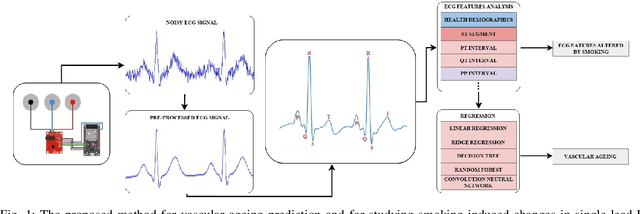
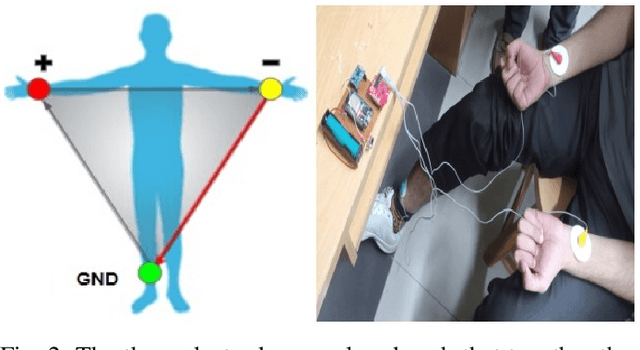
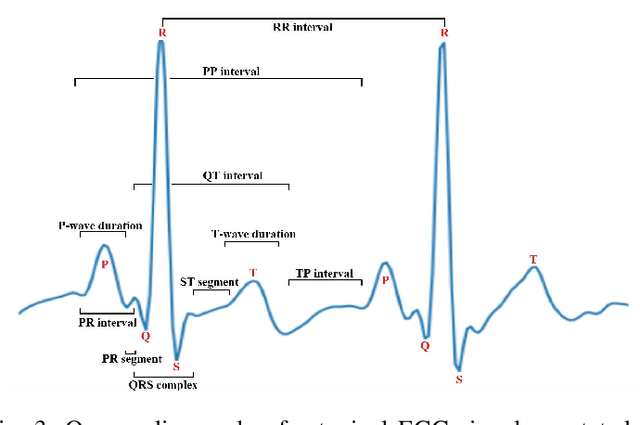
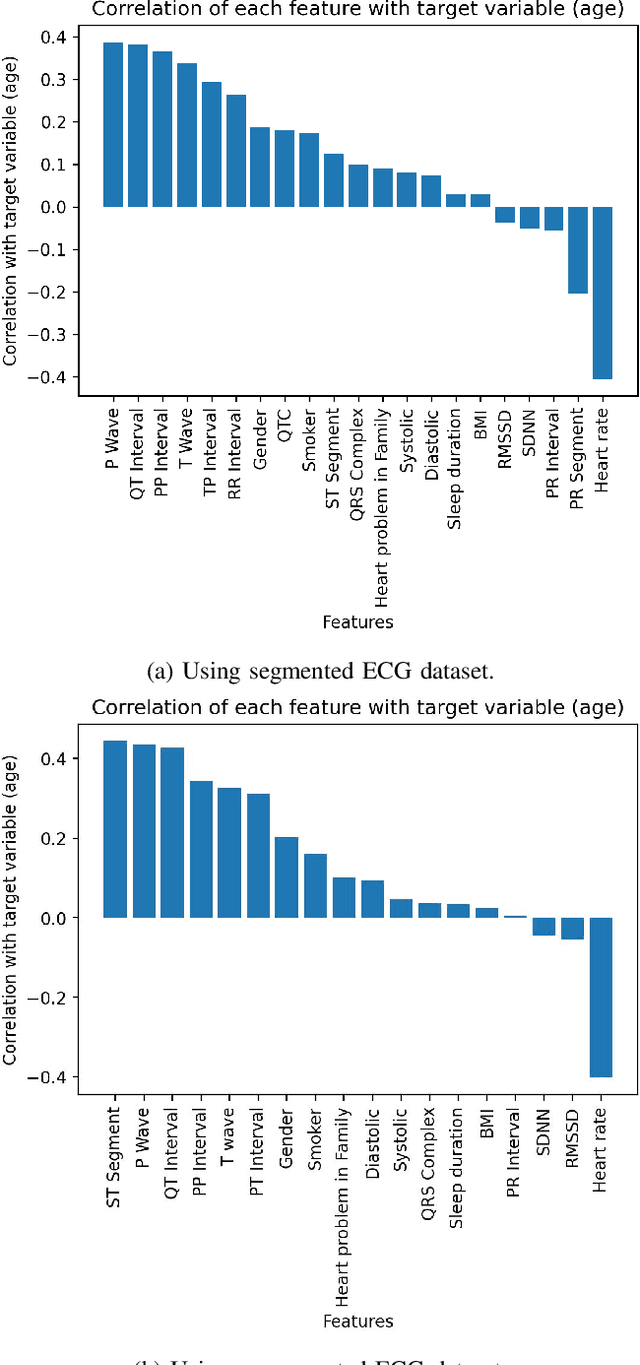
Abstract:This paper presents a novel low-cost method to predict: i) the vascular age of a healthy young person, ii) whether or not a person is a smoker, using only the lead-I of the electrocardiogram (ECG). We begin by collecting (lead-I) ECG data from 42 healthy subjects (male, female, smoker, non-smoker) aged 18 to 30 years, using our custom-built low-cost single-lead ECG module, and anthropometric data, e.g., body mass index, smoking status, blood pressure etc. Under our proposed method, we first pre-process our dataset by denoising the ECG traces, followed by baseline drift removal, followed by z-score normalization. Next, we divide ECG traces into overlapping segments of five-second duration, which leads to a 145-fold increase in the size of the dataset. We then feed our dataset to a number of machine learning models, a 1D convolutional neural network, a multi-layer perceptron (MLP), and ResNet18 transfer learning model. For vascular ageing prediction problem, Random Forest method outperforms all other methods with an R2 score of 0.99, and mean squared error of 0.07. For the binary classification problem that aims to differentiate between a smoker and a non-smoker, XGBoost method stands out with an accuracy of 96.5%. Finally, for the 4-class classification problem that aims to differentiate between male smoker, female smoker, male non-smoker, and female non-smoker, MLP method achieves the best accuracy of 97.5%. This work is aligned with the sustainable development goals of the United Nations which aim to provide low-cost but quality healthcare solutions to the unprivileged population.
Non-Contact Monitoring of Dehydration using RF Data Collected off the Chest and the Hand
Jun 16, 2023



Abstract:We report a novel non-contact method for dehydration monitoring. We utilize a transmit software defined radio (SDR) that impinges a wideband radio frequency (RF) signal (of frequency 5.23 GHz) onto either the chest or the hand of a subject who sits nearby. Further, another SDR in the closed vicinity collects the RF signals reflected off the chest (or passed through the hand) of the subject. Note that the two SDRs exchange orthogonal frequency division multiplexing (OFDM) signal, whose individual subcarriers get modulated once it reflects off (passes through) the chest (the hand) of the subject. This way, the signal collected by the receive SDR consists of channel frequency response (CFR) that captures the variation in the blood osmolality due to dehydration. The received raw CFR data is then passed through a handful of machine learning (ML) classifiers which once trained, output the classification result (i.e., whether a subject is hydrated or dehydrated). For the purpose of training our ML classifiers, we have constructed our custom HCDDM-RF-5 dataset by collecting data from 5 Muslim subjects (before and after sunset) who were fasting during the month of Ramadan. Specifically, we have implemented and tested the following ML classifiers (and their variants): K-nearest neighbour (KNN), support vector machine (SVM), decision tree (DT), ensemble classifier, and neural network classifier. Among all the classifiers, the neural network classifier acheived the best classification accuracy, i.e., an accuracy of 93.8% for the proposed CBDM method, and an accuracy of 96.15% for the proposed HBDM method. Compared to prior work where the reported accuracy is 97.83%, our proposed non-contact method is slightly inferior (as we report a maximum accuracy of 96.15%); nevertheless, the advantages of our non-contact dehydration method speak for themselves.
Your smartphone could act as a pulse-oximeter and as a single-lead ECG
May 21, 2023Abstract:In the post-covid19 era, every new wave of the pandemic causes an increased concern among the masses to learn more about their state of well-being. Therefore, it is the need of the hour to come up with ubiquitous, low-cost, non-invasive tools for rapid and continuous monitoring of body vitals that reflect the status of one's overall health. In this backdrop, this work proposes a deep learning approach to turn a smartphone-the popular hand-held personal gadget-into a diagnostic tool to measure/monitor the three most important body vitals, i.e., pulse rate (PR), blood oxygen saturation level (aka SpO2), and respiratory rate (RR). Furthermore, we propose another method that could extract a single-lead electrocardiograph (ECG) of the subject. The proposed methods include the following core steps: subject records a small video of his/her fingertip by placing his/her finger on the rear camera of the smartphone, and the recorded video is pre-processed to extract the filtered and/or detrended video-photoplethysmography (vPPG) signal, which is then fed to custom-built convolutional neural networks (CNN), which eventually spit-out the vitals (PR, SpO2, and RR) as well as a single-lead ECG of the subject. To be precise, the contribution of this paper is two-fold: 1) estimation of the three body vitals (PR, SpO2, RR) from the vPPG data using custom-built CNNs, vision transformer, and most importantly by CLIP model; 2) a novel discrete cosine transform+feedforward neural network-based method that translates the recorded video- PPG signal to a single-lead ECG signal. The proposed method is anticipated to find its application in several use-case scenarios, e.g., remote healthcare, mobile health, fitness, sports, etc.
Transfer learning for non-intrusive load monitoring and appliance identification in a smart home
Jan 08, 2023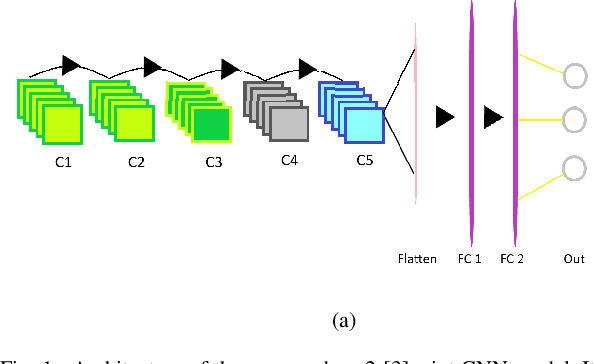

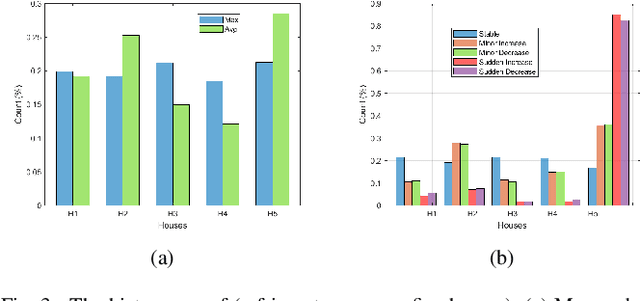

Abstract:Non-intrusive load monitoring (NILM) or energy disaggregation is an inverse problem whereby the goal is to extract the load profiles of individual appliances, given an aggregate load profile of the mains of a home. NILM could help identify the power usage patterns of individual appliances in a home, and thus, could help realize novel energy conservation schemes for smart homes. In this backdrop, this work proposes a novel deep-learning approach to solve the NILM problem and a few related problems as follows. 1) We build upon the reputed seq2-point convolutional neural network (CNN) model to come up with the proposed seq2-[3]-point CNN model to solve the (home) NILM problem and site-NILM problem (basically, NILM at a smaller scale). 2) We solve the related problem of appliance identification by building upon the state-of-the-art (pre-trained) 2D-CNN models, i.e., AlexNet, ResNet-18, and DenseNet-121, which are trained upon two custom datasets that consist of Wavelets and short-time Fourier transform (STFT)-based 2D electrical signatures of the appliances. 3) Finally, we do some basic qualitative inference about an individual appliance's health by comparing the power consumption of the same appliance across multiple homes. Low-frequency REDD dataset is used to train and test the proposed deep learning models for all problems, except site-NILM where REFIT dataset has been used. As for the results, we achieve a maximum accuracy of 94.6\% for home-NILM, 81\% for site-NILM, and 88.9\% for appliance identification (with Resnet-based model).
Hand-breathe: Non-Contact Monitoring of Breathing Abnormalities from Hand Palm
Dec 12, 2022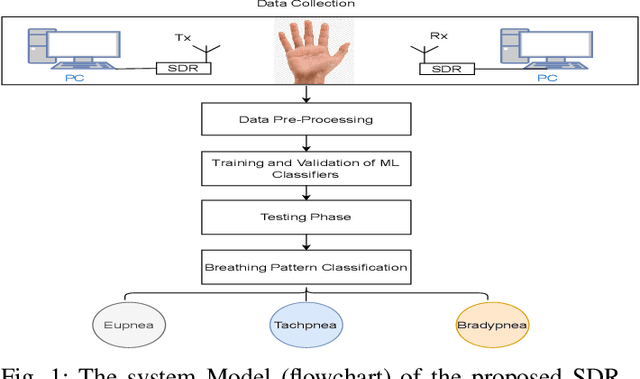
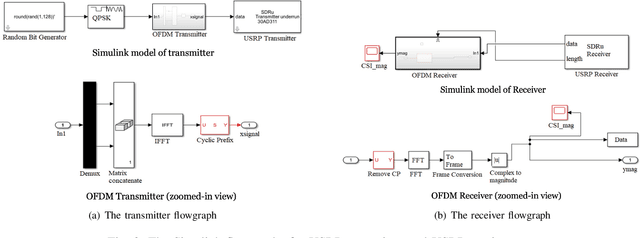
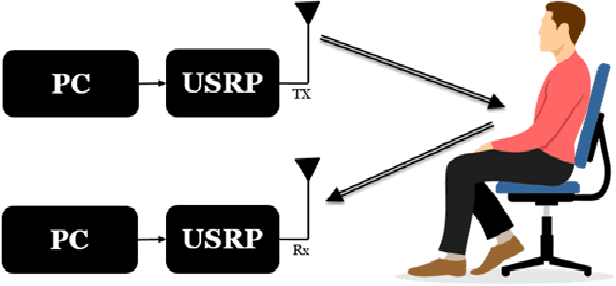

Abstract:In post-covid19 world, radio frequency (RF)-based non-contact methods, e.g., software-defined radios (SDR)-based methods have emerged as promising candidates for intelligent remote sensing of human vitals, and could help in containment of contagious viruses like covid19. To this end, this work utilizes the universal software radio peripherals (USRP)-based SDRs along with classical machine learning (ML) methods to design a non-contact method to monitor different breathing abnormalities. Under our proposed method, a subject rests his/her hand on a table in between the transmit and receive antennas, while an orthogonal frequency division multiplexing (OFDM) signal passes through the hand. Subsequently, the receiver extracts the channel frequency response (basically, fine-grained wireless channel state information), and feeds it to various ML algorithms which eventually classify between different breathing abnormalities. Among all classifiers, linear SVM classifier resulted in a maximum accuracy of 88.1\%. To train the ML classifiers in a supervised manner, data was collected by doing real-time experiments on 4 subjects in a lab environment. For label generation purpose, the breathing of the subjects was classified into three classes: normal, fast, and slow breathing. Furthermore, in addition to our proposed method (where only a hand is exposed to RF signals), we also implemented and tested the state-of-the-art method (where full chest is exposed to RF radiation). The performance comparison of the two methods reveals a trade-off, i.e., the accuracy of our proposed method is slightly inferior but our method results in minimal body exposure to RF radiation, compared to the benchmark method.
Countering Active Attacks on RAFT-based IoT Blockchain Networks
Apr 02, 2022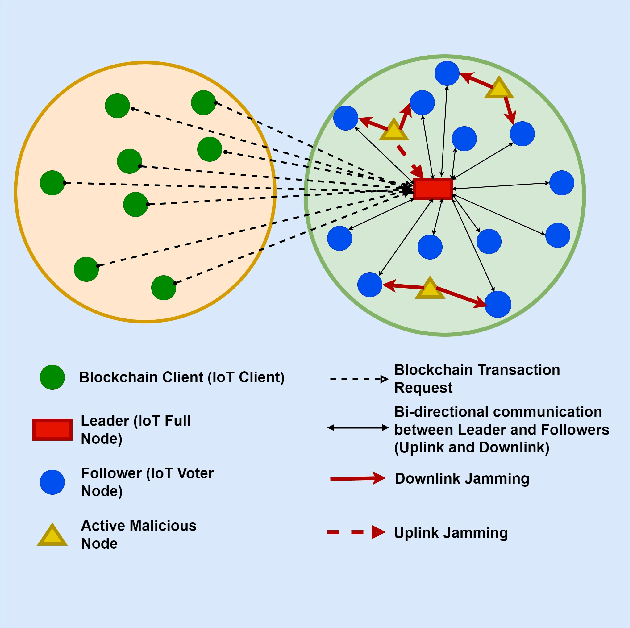
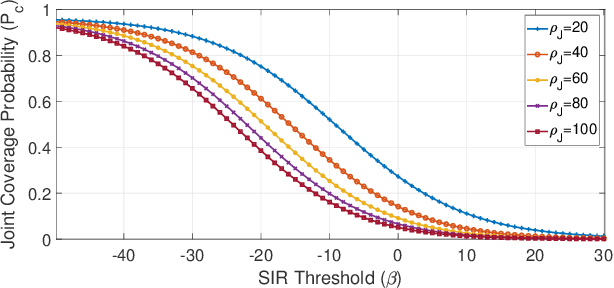
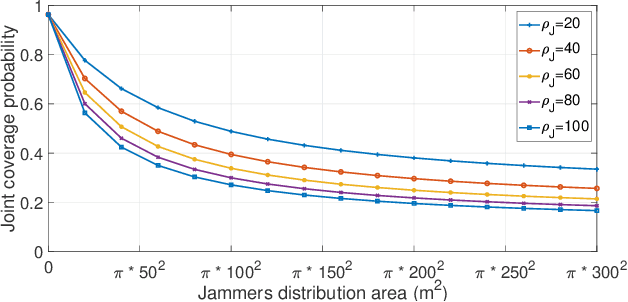
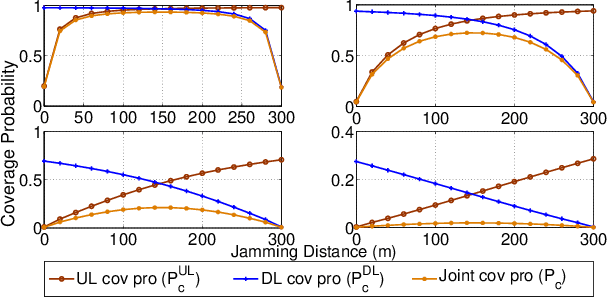
Abstract:This paper considers an Internet of Thing (IoT) blockchain network consisting of a leader node and various follower nodes which together implement the RAFT consensus protocol to verify a blockchain transaction, as requested by a blockchain client. Further, two kinds of active attacks, i.e., jamming and impersonation, are considered on the IoT blockchain network due to the presence of multiple {\it active} malicious nodes in the close vicinity. When the IoT network is under the jamming attack, we utilize the stochastic geometry tool to derive the closed-form expressions for the coverage probabilities for both uplink and downlink IoT transmissions. On the other hand, when the IoT network is under the impersonation attack, we propose a novel method that enables a receive IoT node to exploit the pathloss of a transmit IoT node as its fingerprint to implement a binary hypothesis test for transmit node identification. To this end, we also provide the closed-form expressions for the probabilities of false alarm, missed detection and miss-classification. Finally, we present detailed simulation results that indicate the following: i) the coverage probability improves as the jammers' locations move away from the IoT network, ii) the three error probabilities decrease as a function of the link quality.
Learning-Based Resource Allocation Scheme for TDD-Based CRAN System
Aug 29, 2016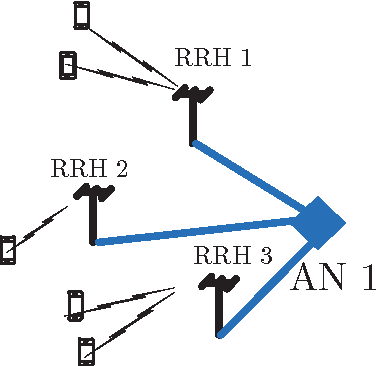
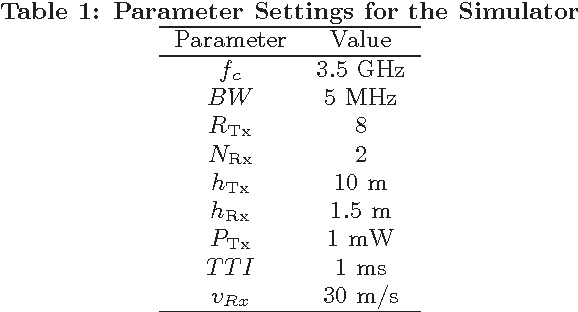
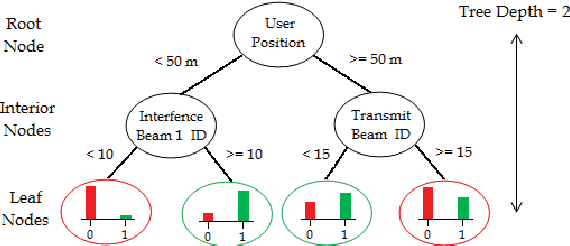

Abstract:Explosive growth in the use of smart wireless devices has necessitated the provision of higher data rates and always-on connectivity, which are the main motivators for designing the fifth generation (5G) systems. To achieve higher system efficiency, massive antenna deployment with tight coordination is one potential strategy for designing 5G systems, but has two types of associated system overhead. First is the synchronization overhead, which can be reduced by implementing a cloud radio access network (CRAN)-based architecture design, that separates the baseband processing and radio access functionality to achieve better system synchronization. Second is the overhead for acquiring channel state information (CSI) of the users present in the system, which, however, increases tremendously when instantaneous CSI is used to serve high-mobility users. To serve a large number of users, a CRAN system with a dense deployment of remote radio heads (RRHs) is considered, such that each user has a line-of-sight (LOS) link with the corresponding RRH. Since, the trajectory of movement for high-mobility users is predictable; therefore, fairly accurate position estimates for those users can be obtained, and can be used for resource allocation to serve the considered users. The resource allocation is dependent upon various correlated system parameters, and these correlations can be learned using well-known \emph{machine learning} algorithms. This paper proposes a novel \emph{learning-based resource allocation scheme} for time division duplex (TDD) based 5G CRAN systems with dense RRH deployment, by using only the users' position estimates for resource allocation, thus avoiding the need for CSI acquisition. This reduces the overall system overhead significantly, while still achieving near-optimal system performance; thus, better (effective) system efficiency is achieved. (See the paper for full abstract)
 Add to Chrome
Add to Chrome Add to Firefox
Add to Firefox Add to Edge
Add to Edge